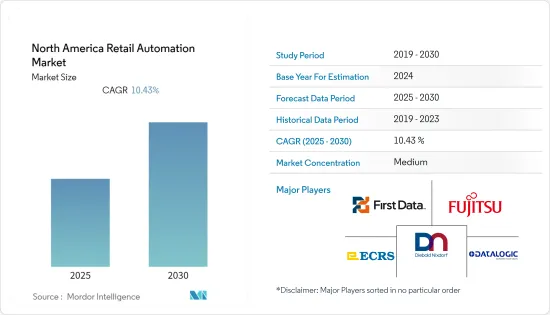Need help finding what you are looking for?
Contact Us
PUBLISHER: Mordor Intelligence | PRODUCT CODE: 1627105

PUBLISHER: Mordor Intelligence | PRODUCT CODE: 1627105
North America Retail Automation - Market Share Analysis, Industry Trends & Statistics, Growth Forecasts (2025 - 2030)
PUBLISHED:
PAGES: 100 Pages
DELIVERY TIME: 2-3 business days
SELECT AN OPTION
The North America Retail Automation Market is expected to register a CAGR of 10.43% during the forecast period.

Key Highlights
- The COVID-19 pandemic created huge disruption in the retail industry and forced retailers to take various preventive measures, leading to the closure of several outlets. Owing to this, retailers and prominent brands across the globe faced short-term challenges across sustained revenues, health and safety, supply chain management, labor shortages, and pricing, to name a few.
- Automation is anticipated to play a major part in the growth of the retail industry; as the industry expands, automation helps retailers cut costs and drive efficiency. These solutions also enhance the customer experience and the efficiency of retail facility employees.
- Retailers are facing challenges as the technological revolution is taking place significantly. These innovations are reshaping the behavior of consumers and their way of collaborating and communicating with each other to select products and services.
- Also, as e-commerce is experiencing steady growth and relocating customers away from retail stores, a new in-store experience must be unique online for the brick & mortar stores to stay relevant. Moreover, digital transformation is helping the supply chain by making data-driven decisions and enhancing the customer experience. Also, players are moving toward iot to enable frictionless retail.
- A study conducted by Zebra Technologies on the anticipated future trends in the retail sector revealed that around 60% of retailers are expected to adopt automation across all the key functions. The study further indicated that around 78% of the respondents would veer towards using kiosks to provide product-related information to their clients.
- Buoyed by the introduction of Amazon Go in the United States, several retailers are now exploring using automation to reduce operational costs and provide a seamless shopping experience to their shoppers. Amazon's entry into physical retail is also seen as a challenge for traditional stores as they now have to compete with established players with a strong distribution channel.
North America Retail Automation Market Trends
Grocery Segment is expected grow at a higher pace.
- Self-checkout kiosks have been among the standard automation solutions increasingly being deployed in supermarkets. Also, grocery chain Kroger uses sensors and predictive analytics to forecast when more cashiers will be needed in its stores.
United States is Expected to Hold a Major Market Share
North America Retail Automation Industry Overview
Additional Benefits:
Product Code: 49035
TABLE OF CONTENTS
1 INTRODUCTION
- 1.1 Study Assumptions and Market Definition
- 1.2 Scope of the Study
2 RESEARCH METHODOLOGY
3 EXECUTIVE SUMMARY
4 MARKET DYNAMICS
- 4.1 Market Overview
- 4.2 Market Drivers
- 4.2.1 Rising Demand for Faster Services
- 4.2.2 Growth Among Retail Industry and E-commerce
5 MARKET SEGMENTATION
6 COMPETITIVE LANDSCAPE
7 INVESTMENT ANALYSIS
8 MARKET OPPORTUNITIES AND FUTURE TRENDS
Have a question?


SELECT AN OPTION
Have a question?


Questions? Please give us a call or visit the contact form.
